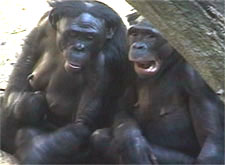Perhaps there were other reasons that the bonobos weren’t playing with each other sexually this hot Indian Summer morning. The zookeeper, who kindly showed us around, apologized for being late, saying she’d had to “separate the females” and “keep them from bonding” or else they’d “attack the males.” Sounded reasonable enough. But my hunch is that that “bonding” is euphemistic Zoo Talk for female-female sex play, also called “genito-genital rubbing” by primatologists, or “hoka-hoka” by the Mogandu people indigenous to the bonobos' native habitat in the Congo, and that the zookeeper was doing whatever zookeepers do to keep the females from having sex with each other.
Female bisexuality is the centerpiece of bonobo society. So perhaps when these (probably higher ranking) females were physically separated, the rest of the tribe fell into a bit of a funk. In any case, they weren’t doing much, and my French friends were slightly disappointed. Of course, even when they’re not engaged in sex, even when they're just lying around looking hot and bored, bonobos are delightful to behold. They look so similar to us, so almost-human in their physiognomy and mannerisms; you can gaze into their big brown eyes and feel as if you've found the Missing Link.

Kiri huddles with Lana and her baby .. PHOTO: Theron
Marks
So there we were, the five of us, Theron, Samantha, my two French friends and me, feeling pretty lethargic ourselves in the gathering heat, but thoroughly enjoying this opportunity to commune with our chimp cousins. We noticed Lana, now the oldest, the Alpha female of the tribe squatting by the creek with Kiri, a younger female with an extremely expressive face. Kiri made faces at us as Lana calmly took in the scene, a tiny month-old infant nursing at her ample breast.